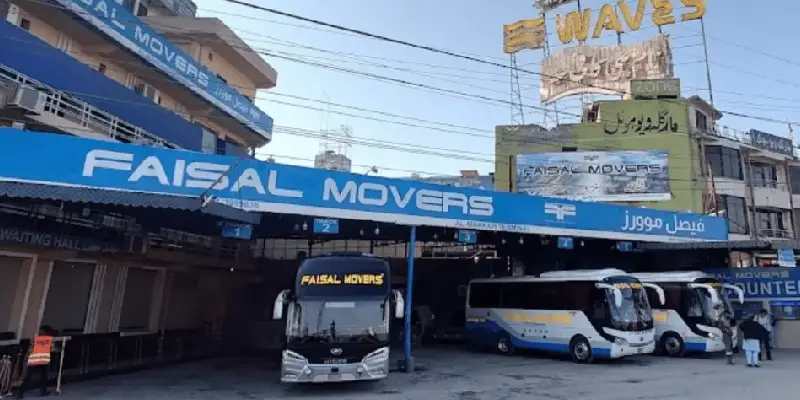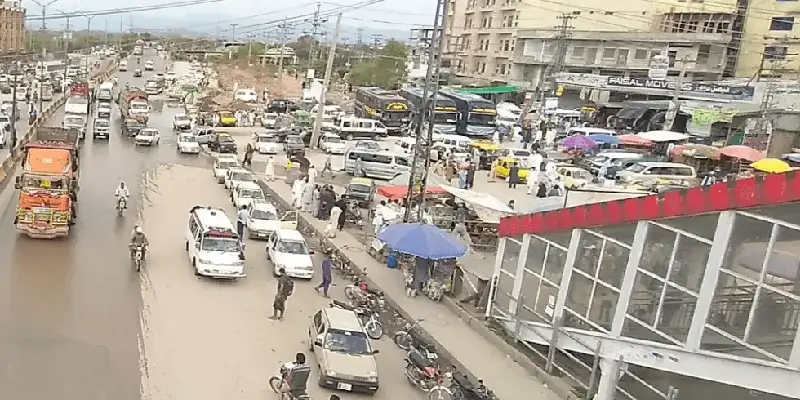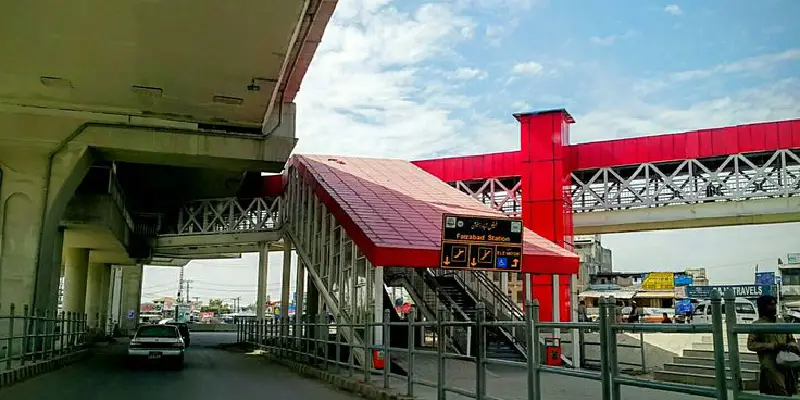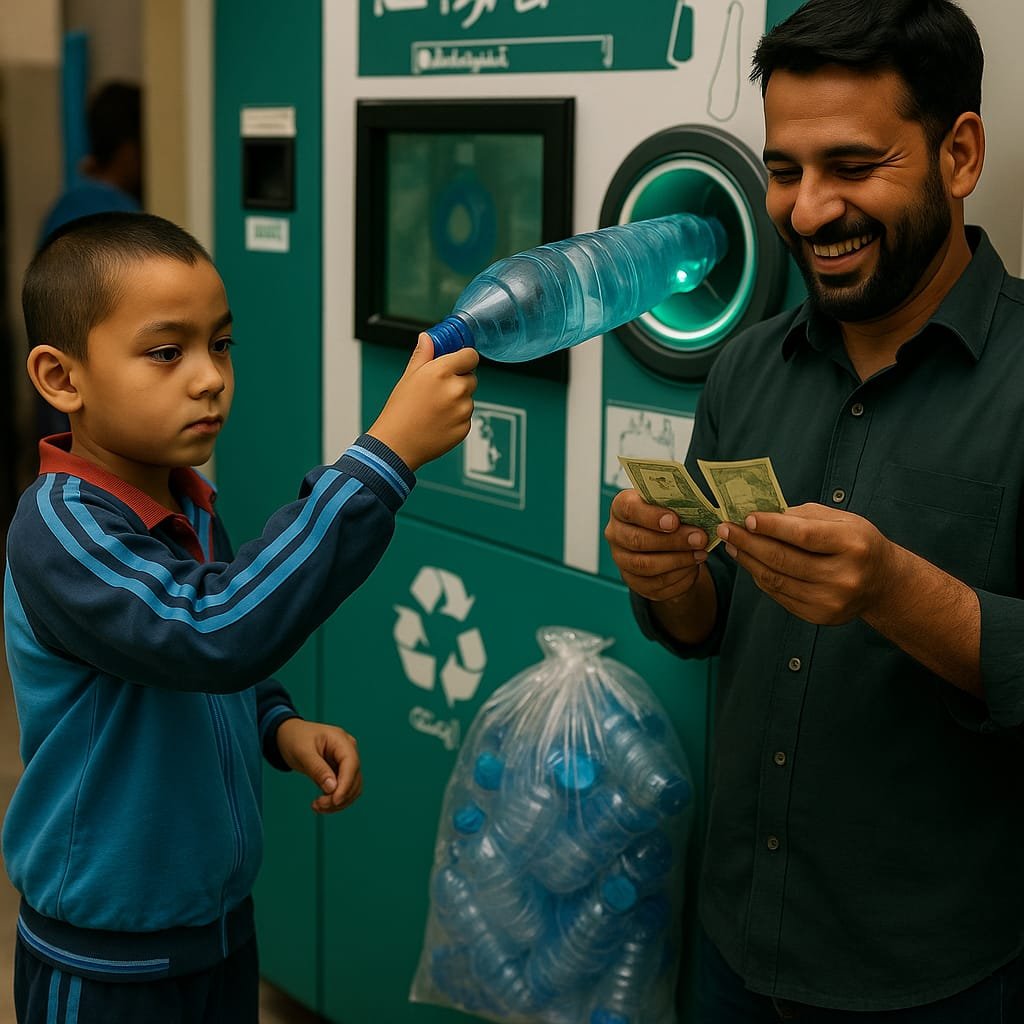Faizabad isn’t just a location it’s a movement. It’s the point where Islamabad and Rawalpindi meet, clash, connect, and carry on. If you live in either city, chances are you’ve passed through Faizabad more times than you can count.
It’s not just a bus stop or an interchange.It’s a space where daily life unfolds in fast-forward traffic jams, street vendors, students rushing for vans, and political rallies that can bring everything to a halt.
From early morning chaos to late-night calm, Faizabad is always alive. It’s where people wait, walk, protest, or pause on their way somewhere else. It has played host to major national events and everyday hustle alike.
And even if you’re just passing through, Faizabad always leaves an impression sometimes frustrating, sometimes unforgettable.

In this blog, we’ll take a closer look at what makes Faizabad more than just a busy junction. Whether it’s part of your daily commute or just a name you’ve heard in the news, there’s more to this place than traffic and noise.
Table of Contents
ToggleFaizabad Bus Station: The Twin Cities’ Travel Lifeline
Faizabad Bus Station is one of the busiest and most important transport hubs in all of Pakistan. Located right at the intersection between Islamabad and Rawalpindi, it’s the go-to place for thousands of commuters every single day.
Whether you’re heading to work, traveling across the country, or just going from one city to the other, chances are your journey will pass through Faizabad.

What Makes Faizabad Bus Station So Important?
The reason this station is so central isn’t just its location it’s what it connects. From Faizabad, you can catch buses, vans, and wagons going to almost every major part of Rawalpindi, Islamabad, and beyond.
It’s often seen as the “starting point” for daily life, especially for office workers, students, and shopkeepers.
-
Local Routes: Public vans and Suzuki pickups operate from here to areas like Saddar, Murree Road, G-9, Aabpara, Pirwadhai, and more.
-
Intercity Travel: Long-route buses and coaches heading to cities like Lahore, Peshawar, Faisalabad, and Sialkot either pass through or stop nearby.
-
Metro Bus Access: The Faizabad Metro Bus Station is connected to the main Rawalpindi-Islamabad Metro route, making it even easier for passengers to travel between the two cities.
What You’ll See at the Station
Faizabad Bus Station is always buzzing with life. You’ll find:
-
Vans parked in lines, with conductors shouting destinations to attract passengers.
-
Street vendors selling everything from fruit to samosas, phone chargers to socks.
-
Rickshaw drivers and taxi operators looking for passengers heading into deeper parts of Islamabad or Rawalpindi.
-
Porters and helpers assisting travelers with heavy bags, especially on long-route buses.
It’s noisy, crowded, and a little chaotic but that’s exactly what gives it character. For many people, it’s a familiar part of their daily routine.
Challenges of Faizabad Bus Station
Despite its importance, Faizabad Bus Station does face problems:
-
Traffic Congestion: The area often gets jammed, especially during peak hours or political events.
-
Lack of Facilities: There are limited seating areas and shelter for waiting passengers, especially during bad weather.
-
Cleanliness and Maintenance: Due to the high volume of people, cleanliness is a challenge, and infrastructure is often in need of upgrades.
-
Informal System: Many vans operate without formal schedules or ticketing systems, which can confuse first-time users.
Why People Still Rely on It
Even with its flaws, Faizabad Bus Station remains essential. It’s affordable, widely accessible, and connects people from all walks of life.
For students commuting to schools and universities, laborers traveling for work, or families visiting relatives this station is a lifeline.
It’s not fancy, but it works. It gets people where they need to go.
A Symbol of Daily Life
Faizabad Bus Station represents more than transport it’s a symbol of how cities move and breathe. It’s where the fast pace of Islamabad meets the local energy of Rawalpindi.
It’s part of the routine, part of the struggle, and part of the system that keeps both cities going.
If you ever want to feel the real pulse of the twin cities, just spend 15 minutes standing at Faizabad Bus Station. You’ll hear a hundred stories passing by.
Faizabad Rawalpindi
Faizabad is one of the busiest and most sensitive intersections in the Islamabad-Rawalpindi region. It connects two major cities and serves as both a transport lifeline and a political hotspot.
Location and Connectivity
Faizabad is located right at the edge of Islamabad’s Sector I-8 and Rawalpindi’s Shamsabad area. It sits on Murree Road, a major artery that runs between the two cities. The interchange connects:
-
Murree Road (from Rawalpindi)
-
IJP Road (heading towards Pirwadhai and Peshawar Road)
-
Islamabad Expressway (towards Faizabad Metro Station and Zero Point)
-
Sectors I-8 and H-8 (Islamabad)
This makes it a key connector not just for daily commuters, but also for intercity transport heading towards other provinces.
Transport and Commuter Hub
Faizabad serves as a major public transport exchange. Thousands of people pass through it every day using:
-
Metro Bus Service (Rawalpindi-Islamabad route)
-
Suzuki vans, buses, and rickshaws
-
Private cars and ride-hailing apps like Careem and InDrive
According to traffic data from the Rawalpindi Development Authority (RDA), over 200,000 vehicles use Faizabad daily during working days. It’s busiest between 7:30–9:30 AM and 5:00–7:30 PM.
The nearby Faizabad Bus Terminal also serves as a departure point for long-route buses heading to cities like Lahore, Gujrat, and even Muzaffarabad.
Political Significance
Faizabad has become widely known as a protest site. Its location between the two cities gives it high visibility and quick media attention. Protesters often choose Faizabad to create disruption that pressures the government.
The most famous example is the Faizabad Dharna of 2017, organized by Tehreek-e-Labbaik Pakistan (TLP). It lasted over 20 days and blocked all major routes into Islamabad. The sit-in led to:
-
Severe disruption of daily life
-
Shutdown of schools and offices
-
Limited access to hospitals and services
-
A government operation to disperse protesters
-
A Supreme Court inquiry on how the protest was handled
Since then, Faizabad is frequently mentioned in discussions about protest rights, public inconvenience, and law enforcement.
Commercial and Local Surroundings
Faizabad is surrounded by a mix of commercial activity and residential zones. Some important nearby areas include:
-
Shamsabad and Satellite Town (Rawalpindi side)
-
I-8 and H-8 (Islamabad side)
-
Holy Family Hospital and Rawalpindi Arts Council
-
Allama Iqbal Open University and several private colleges
-
Daily markets and bus stands
The area is also dotted with budget hotels, tea stalls, pharmacies, and fruit vendors, making it a bustling local center for many people living in the twin cities.
Traffic and Infrastructure Challenges
Despite its importance, Faizabad struggles with some serious issues:
1. Traffic Congestion
Peak hours often turn the area into a bottleneck. The high number of merging roads and lack of alternate routes make traffic management very difficult.
2. Encroachments
Footpaths are often occupied by vendors, making it hard for pedestrians to walk safely. These stalls also spill onto the road, creating more congestion.
3. Rainwater Drainage
The interchange gets waterlogged during monsoon season. Poor drainage leads to flooding that can last for hours, affecting both traffic and nearby shops.
4. Protest Disruptions
Whenever a protest is announced in Islamabad, most people check whether it will block Faizabad. Offices close early, and public transport becomes risky. The fear of being stuck here for hours is real.
Government Efforts and Recent Developments
In the last few years, local authorities have taken steps to ease the situation:
-
CDA and RDA worked together to redesign parts of the interchange.
-
Digital traffic signals and U-turn adjustments were introduced.
-
Encroachment removal drives were carried out in 2022 and 2023.
-
A plan was proposed to build a flyover for smoother traffic flow, although work is still in early stages.
The Metro Bus service has helped reduce pressure from public transport to some extent, but the area still needs long-term planning.
A Symbol of Urban Pressure
Faizabad is more than just a chowk. It represents the daily hustle of working-class people, the unpredictability of political protests, and the urban challenges of a growing metro region.
If you live in Rawalpindi or Islamabad, you’ve probably been stuck here at least once either due to traffic or some unexpected protest.
For many, Faizabad is both a necessity and a headache a place they rely on but often wish they could avoid.
Faizabad Stop
Faizabad Stop is one of the busiest public transport stops in the Islamabad-Rawalpindi region. Located right at the Faizabad Interchange, it acts as a key pickup and drop-off point for thousands of people every day.

Location and Accessibility
Faizabad Stop is positioned between Rawalpindi’s Shamsabad area and Islamabad’s Sector I-8. It lies on Murree Road, close to the Metro Bus corridor and Faizabad Flyover.
It’s easily accessible from:
-
IJP Road (coming from Pirwadhai or Peshawar Road)
-
Murree Road (from Rawalpindi city)
-
Islamabad Expressway (leading toward Zero Point and beyond)
This central location makes it a natural stop for all kinds of public transport.
Public Transport Hub
Faizabad Stop is a key transfer point for:
-
Metro Bus Service (Rawalpindi-Islamabad line)
-
Local vans and Suzuki pickups
-
Private buses going to nearby towns like Kahuta, Murree, Gujar Khan
-
Ride-hailing services like Careem, Bykea, and InDrive
-
Inter-city coaches for longer routes
If you’re coming from Rawalpindi and heading toward Blue Area, Aabpara, or even Bhara Kahu, this stop is often where you’ll change rides or board a Metro bus.
On average, over 50,000 passengers use Faizabad Stop daily, according to a 2023 CDA report.
Facilities at Faizabad Stop
The stop itself is quite basic, but essential:
-
Sheltered waiting areas (especially for Metro passengers)
-
Ticket booths for Metro Bus
-
Footbridges for safe crossing
-
Nearby snack shops, fruit vendors, and tea stalls
-
Access to toilets in nearby terminals or shops
-
Rickshaw and taxi stands
However, the stop lacks proper seating, cleanliness, and sometimes has no shade during the summer heat which can be a problem for the elderly or women with children.
Issues and Complaints
Despite being such a key stop, there are a few common issues commuters often talk about:
1. Overcrowding
During rush hours, the stop gets extremely packed. Buses are full, people are standing on the road, and there’s barely any room to wait comfortably.
2. Encroachments
Vendors occupy most of the walking space, making it hard for passengers to move freely, especially women and elderly people.
3. Poor Cleanliness
Garbage piles up around the area due to lack of waste bins and cleaning staff.
4. Security Concerns
Although police presence increases during sensitive times, petty theft and harassment have been reported in crowded areas near the stop.
Nearby Landmarks
If you’re at Faizabad Stop, you’re close to:
-
Metro Bus Terminal (Faizabad Station)
-
Allama Iqbal Open University
-
Shamsabad Sports Complex
-
Holy Family Hospital (a short rickshaw ride away)
-
Faizabad Market for food, clothing, and mobile accessories
Role in Everyday Life
For thousands of office workers, students, laborers, and small business owners, Faizabad Stop is part of their daily routine. It’s where the day begins and ends.
Whether it’s someone catching the Metro to Blue Area or a fruit seller heading to Raja Bazaar, this stop plays a quiet but essential role in the city’s rhythm.
It’s also a place where strangers share a bench, where people help each other find the right van, and where chai breaks happen on the go. In many ways, Faizabad Stop reflects the everyday hustle of Pakistan’s urban middle and working class.
Faizabad Metro Station
Faizabad Metro Station is one of the most important stops on the Rawalpindi-Islamabad Metro Bus route. Located at the Faizabad Interchange, it serves as a central link between the two cities and handles thousands of passengers every day.

Location and Route Connection
Faizabad Metro Station sits right between Saddar Rawalpindi and Blue Area Islamabad, making it a key stop for daily commuters.
It connects directly to:
-
Saddar, Committee Chowk, Waris Khan, and Liaqat Bagh (Rawalpindi side)
-
I-8, Zero Point, 7th Avenue, and Secretariat (Islamabad side)
Because of its location at the border of Rawalpindi and Islamabad, it’s often seen as the dividing point where most passengers either begin or end their city-to-city travel.
Daily Passenger Volume
Faizabad is one of the busiest stations on the Metro Bus line. According to the Punjab Masstransit Authority (PMA), around 30,000 to 35,000 passengers use this station daily during weekdays.
Most users are:
-
Office workers heading to Islamabad
-
Students from nearby colleges and universities
-
Laborers and shopkeepers commuting from low-income areas
It also serves as a major transfer point, where people switch from local vans or rickshaws to the Metro system.
Station Facilities
The station is designed for high traffic and provides the following facilities:
-
Elevated platform with covered roofing
-
Ticketing booth and automatic ticket vending machines
-
Security checks with metal detectors and guards
-
Escalators and stairs (but escalators often out of order)
-
Free Wi-Fi available at most times
-
Dedicated lanes for buses, making arrival and departure quick
The station is part of the Red Line of the Metro system, and it’s located just above the Faizabad Interchange.
Nearby Access Points
The Faizabad Metro Station gives easy access to:
-
Allama Iqbal Open University
-
Shamsabad and Satellite Town
-
IJP Road
-
Murree Road Markets
-
Holy Family Hospital (reachable by rickshaw in 5–7 minutes)
It’s also close to bus and van terminals, where travelers catch rides to Murree, Gujar Khan, and even Azad Kashmir.
Challenges at Faizabad Metro Station
Even though it’s a key part of the Metro system, there are still a few issues:
1. Overcrowding During Peak Hours
The station gets packed during morning and evening rush hours. Buses arrive full, and passengers often have to wait for the next one.
2. Maintenance Issues
Sometimes escalators don’t work, and the cleanliness of stairways and platforms needs improvement.
3. Limited Parking
There’s no proper parking space for motorcycles or cars, so people park on the roadside, which causes blockage and inconvenience.
4. Security Concerns at Night
After 8 PM, the station becomes less crowded, and women or solo travelers may feel uncomfortable due to poor lighting and fewer staff.
Why It Matters
For many working-class families in Rawalpindi and Islamabad, the Metro system has made life easier and more affordable. Faizabad Station is at the heart of that system.
It cuts travel time, saves money, and helps reduce road congestion. At a fare of just Rs. 30 (as of 2024), the Metro offers a safe and reliable option, especially for those who can’t afford ride-hailing services or fuel costs.
Final Thoughts
Faizabad isn’t just a name you hear on the news or see on a bus sign it’s the heartbeat of daily life between Rawalpindi and Islamabad.
Whether it’s the interchange, the Metro Station, or the local bus stop, Faizabad plays a central role in how people move, work, and live in the twin cities.
Yes, it has its problems traffic, protests, overcrowding, and poor maintenance but it’s still a place that thousands rely on every single day.
From students catching the Metro to vendors setting up stalls near the stop, life at Faizabad is fast, messy, and very real.
If there’s one thing Faizabad shows us, it’s how deeply connected transport, politics, and daily life are in Pakistan’s urban centers. It’s not perfect but it’s important. And it’s not going away anytime soon.




